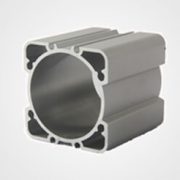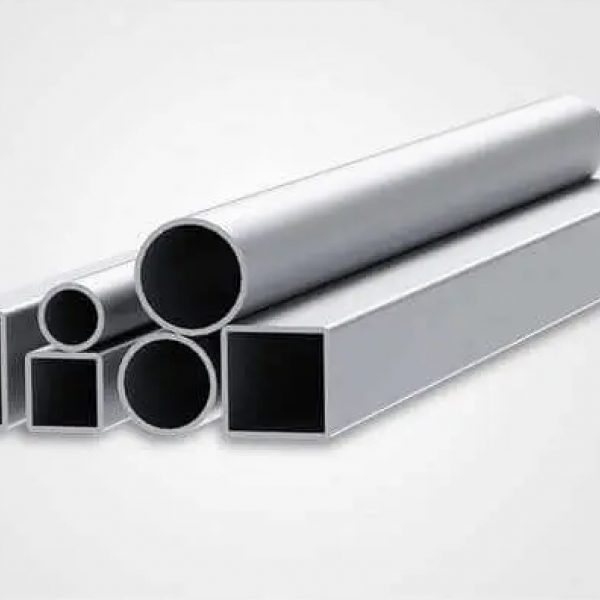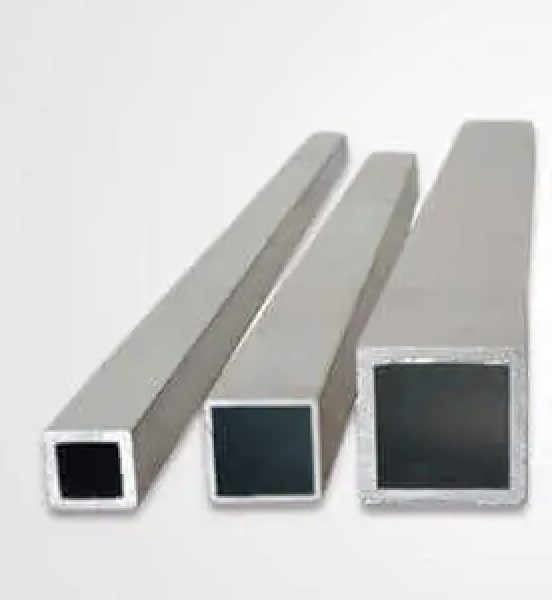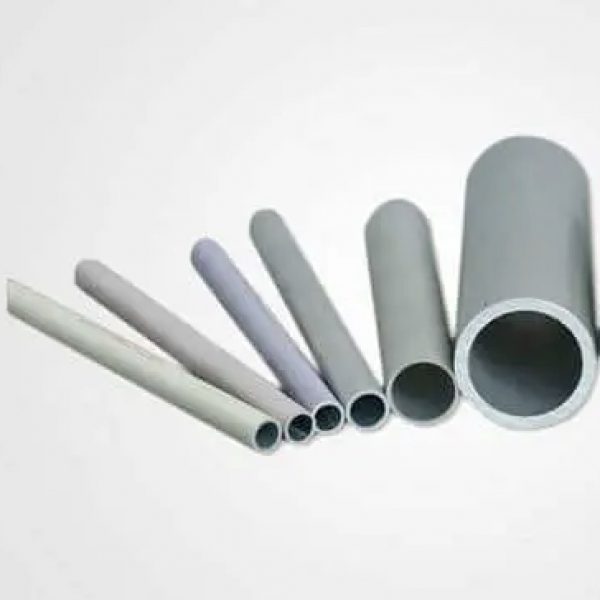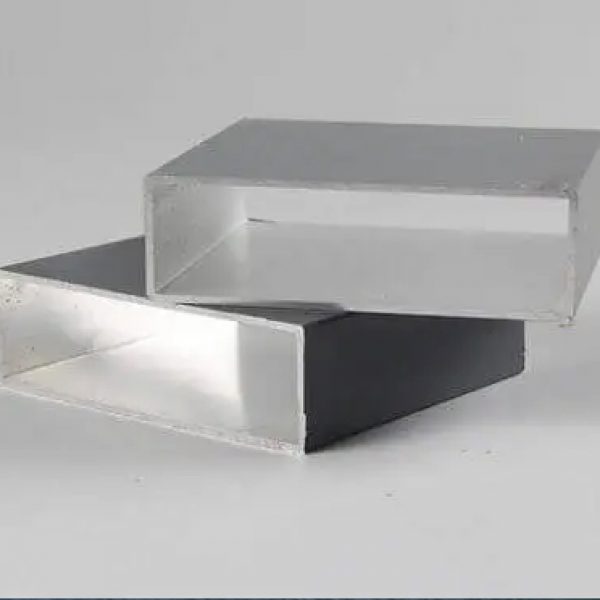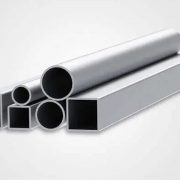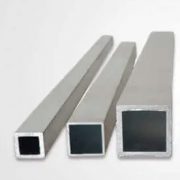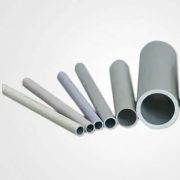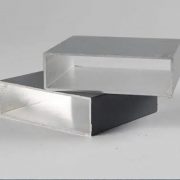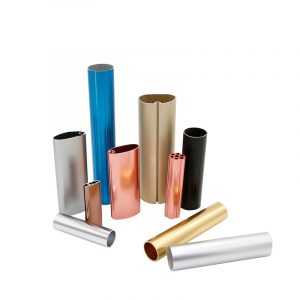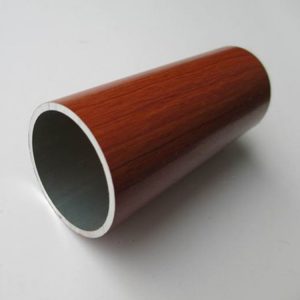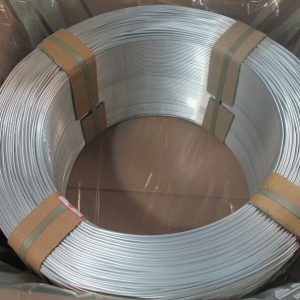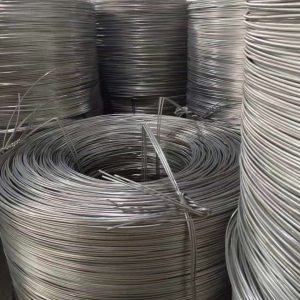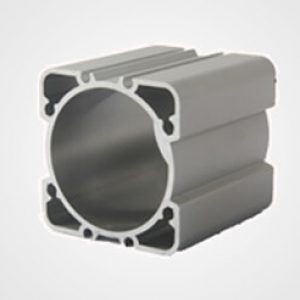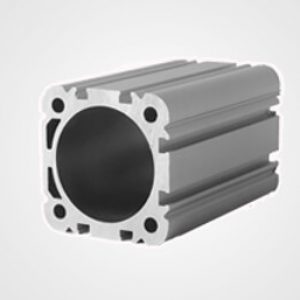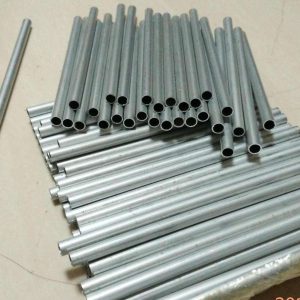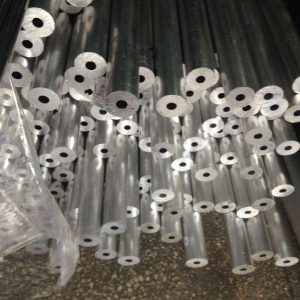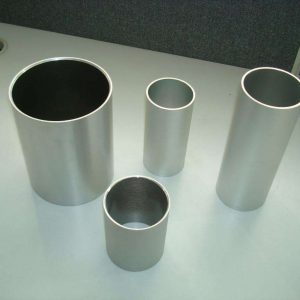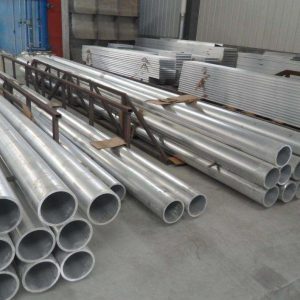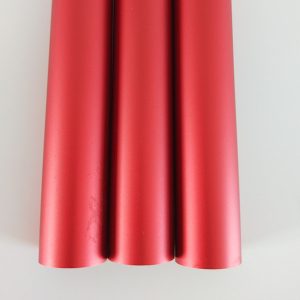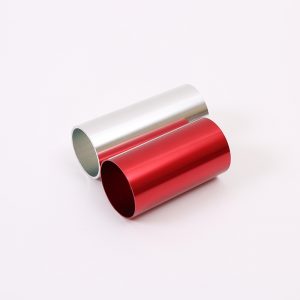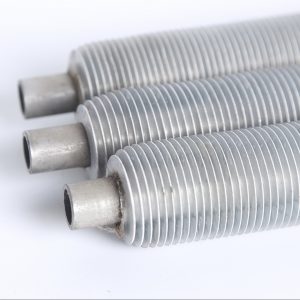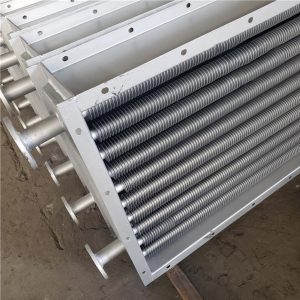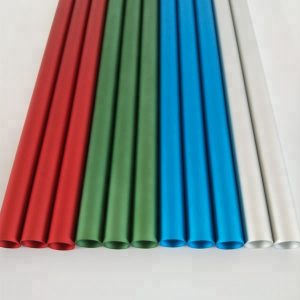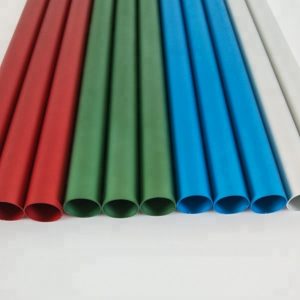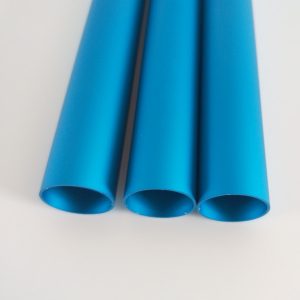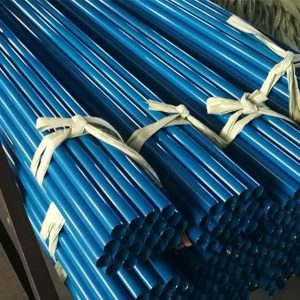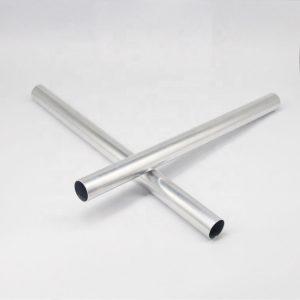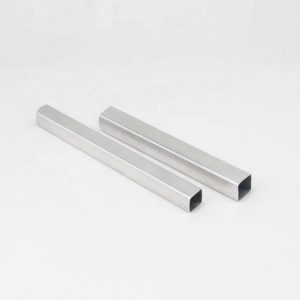Extruded Aluminum Tube
What I’m sure of is that at some point in time, you ought to have seen or come across this particular material, whether knowingly or unknowingly.
Well, an extruded aluminum tube primarily refers to the type of aluminum profile made from extrusion process to produce desired sectional shape and size.
In other simple words, it refers to an aluminum tube formed by forcing it to flow through a tube-shaped opening die.
And at the end of the process, it emerges as an elongated piece with a similar profile as the die opening.
In many instances, you’ll find that many manufacturers tend to produce different types of extruded aluminum tubes.
Of course, the essence, in this case, is for making sure that they are suitable for each application.
But we shall look at this aspect later in on in this guide, so do not worry!
In the meantime, let’s find out some of the major properties that make extruded aluminum tube one of the best material for different applications.
- Description
- Specifications
- Properties of Extruded Aluminum Tube
- Inquiry
Your Reliable Extruded Aluminum Tube Manufacturer
Grand as an extruded aluminum tube manufacturer and supplier owns hundreds of standard aluminium tube comes in various dimension and thickness. We have an available mold for this extruded aluminum tube, please consult our sales team, which can shorten the delivery time and let you receive the goods faster.

| Item Type | extruded aluminum tube |
| Material | 1000series ~ 7000series aluminium |
| Temper | F, O,T3511, T4,T5,T6,T6511, T72, H12,H112 etc. |
| Shapes | Round, rectangular,Oval, Square and custom |
| Thickness | 0.50mm–Customized |
| Color | customized color |
| Cut Lengths | According to customer needs |
| Application | In furniture, windows&doors, decorations ,industry, construction and so on |
| Tolerances | Outside diamter:* +/0.003″ Inside Diameter:” +/-.001″ |
| Certificate | CE/SGS/ISO/Rohs |
| Service | 1. Free sample, Free design; 2. OEM/ODM available; 3. Custom-made request; 4. New design solution suggestion |
| Surface treatment | Anodizing, Mill finish, Electroplating, Polishing, Sand blasted, Powder coating, Silver plating, Brushed, Painted, PVDF etc. |
| Deep process | CNC,drilling,milling,cutting,stamping,welding,bending,assembling,Custom Aluminum Fabrication |
| MOQ | Low MOQ |
| Packaging | standard export packaging or as discussed |
| OEM & ODM | Available.our engineers can check and discuss your design , great help ! |
| Free Samples | Yes,we can provide free sample |
| Delivery time | 15-20 days after sample confirmed & down payment, or negotiated |
| Port | Shanghai Port/Shenzhen Port/Ningbo Port |
Grand as extruded aluminum tube manufacturer for almost 18 years. We produce Aluminum Round tube, aluminum square tubing, Aluminum rectangular Tubing& aluminum oval tube.
The most common alloy no. to produce an extruded aluminum tube is 6061 and 6063. Both of them have good corrosion resistance, wearability, and a good outlook for anodized aluminum tubes. Wellste provides various kinds of surface treatment.
Are you looking for thin wall aluminum tubing? Here in Grand, we are specialized in producing extruded aluminum tube with wall thickness as thin as 0.3mm. Grand Aluminum is thin wall aluminum tubing expert.
What is Extruded Aluminum Tube?
What I’m sure of is that at some point in time, you ought to have seen or come across this particular material, whether knowingly or unknowingly.
Well, an extruded aluminum tube primarily refers to the type of aluminum profile made from extrusion process to produce desired sectional shape and sizes

Extruded aluminum tube
In other simple words, it refers to an aluminum tube formed by forcing it to flow through a tube-shaped opening die.
And at the end of the process, it emerges as an elongated piece with a similar profile as the die opening.
In many instances, you’ll find that many manufacturers tend to produce different types of extruded aluminum tubes.
Of course, the essence, in this case, is for making sure that they are suitable for each application.
But we shall look at this aspect later in on in this guide, so do not worry!
In the meantime, let’s find out some of the major properties that make extruded aluminum tube one of the best material for different applications.
Properties of Extruded Aluminum Tube
This is the thing!
For you to consider any material suitable for the particular application, you have to look into various elements revolving around it.
One of these elements is, of course, the properties that the material possess, which somehow makes it better than other available options.
In this guide, I want us to look at some of the key properties of extruded aluminum tube and enable you to understand why it’s ideal.

Extruded aluminum specifications
a) Lightweight
Yes, extruded aluminum tube is somehow lightweight.
And this is essential because it makes it possible for you to use it conveniently in a wide range of applications since it is easy to carry around.
The fact that it is lightweight also shows that you can use it easily for other fabrication needs, especially when carrying out a project.
The lightweight nature of this material would also mean that it is convenient to transport especially when importing from overseas countries.
Furthermore, it also makes it attractive for a number of uses where applications that consider weight as a priority, such as transportation.
b) Good heat conductor
The extruded aluminum tube is arguably one of the best materials with excellent thermal conductor properties.
In fact, if you compare it with other common metals, this one tends to conduct heat as well as cold better.
And evidently, this property is ideal particularly for applications that require heat dissipation or heat exchangers.
For instance, a perfectly designed extruded aluminum tube allows for sufficient heat dissipation mostly in housing as well as other components.
c) Comes in several alloys
Incidentally, extruded aluminum tubing involves a combination of different types of alloys.
This is what makes it one of the best material for several types of applications given the guarantee that it is strong.
You see, common alloying elements such as Manganese, silicon, Zinc, Copper, and magnesium makes it possible for the metal to attain necessary strength.
Nonetheless, other smaller amounts of elements such as Lead, titanium, chromium and vanadium may as well be added for specific purposes.
And that’s why you realize that extruded aluminum tube is somewhat durable and strong since it integrates different elements into one.
d) Smooth surface finish
Just like I have mentioned above, the fact that you can add different elements when extruding aluminum tubes makes you attain different elements.
Well, this material has a smooth surface finish, of course, because, during the extrusion process, you can add the elements to that effect.
The good thing with a smooth surface finish is that it makes it possible for you to obtain attractive projects when using this material.
Also, it makes it easy for you to decorate the surfaces using various means and ensure that you get the desired results.
e) Resistant to corrosion
So this is the thing, the extruded aluminum tube contains a wide range of elements which have different properties.
This combination, therefore, makes it possible for the material to be resistant to corrosion and also other several environmental and physical elements.
Ordinarily, this material does not rust, and its surface is protected by its own naturally occurring oxide file.
Moreover, you can as well enhance this protection by anodizing it or better still by using other different means of finishing.
f) Environmentally friendly
You have to know that extruded aluminum tube is noncombustible and non-toxic.
In other words, what I’m trying to say here is that this material never burns or produces toxic fumes even at extreme temperatures.
Furthermore, it is sustainable, which means that you can recycle it infinitely without degradation in properties.
What you ought to know is that in most cases, extruded aluminum material is often produced with high recycled content.
And while at it, this does not necessarily compromise functionality and aesthetics.
What’s more is that the inherent properties of the extruded aluminum tube such as lightweight, design flexibility and strength also makes it beneficial to the environment.
g) Easy to fabricate and assemble
When you’re dealing with extruded aluminum tube, you’ll notice that it can significantly simplify subsequent fabrication and assembly.
Again, quite several fabrication processes are often employed in the production of this type of material.
And in line with that, you’ll notice that using this type of metal guarantees seamless, reflective, resilient and strong projects

Colorful anodized surface
In the next section, I want us to go further and discuss some of the common types of the extruded aluminum tube you’re likely to come across.
Types of Extruded Aluminum Tubes
Well, by now, I guess you understand that aluminum I possibly one of the most popular metals used for various applications.
However, you need to know that this metal does not necessarily come in its pure form.
What this means is that there are quite a number of processes involved to make it suitable for a particular function.
Definitely, extrusion tubing is one of the ways of purifying and also enhancing the properties of this metal.
In this section, I want us to look at some of the common types of the extruded aluminum tube that you can easily come across.
So let’s quickly find out more about the same;
- Round extruded aluminum tube – just as the name suggests, this one is more of a cylindrical shape and comes in various sizes depending on the application. Round aluminum tubes look like this:

Round aluminum tubes
In other words, this is the type of pipe that is derived from a solid aluminum bar and formed in solid round shape.
This type of pipe is known for its ability to withstand pressure, effectively in comparison to other pipe manufacturing processes.
And that’s the reason you’ll notice that such tubes are commonly used in high-pressure applications.
- Extruded aluminum square- this one comes in the form of a square bar and also has various sizes of course depending on the type of application. Below is an example of square aluminum tube:

Square aluminum tube
- Extruded Aluminum Oval Tubing – like the name suggests it comes is a flat oval shape bar that are used mostly for decoration, window and door profiles.

Figure 6 Oval aluminum tube
- Extruded Aluminum Rectangular Tube- this is an extruded product with a number of applications in different fabrication and building projects due to its ideal properties. Below is an example of aluminum rectangle tubing:

Rectangle aluminum tubing
- Telescopic Aluminum Tubing – it refers to the type of extruded tube that is needed when the ability to adjust piping to account for unknown changing width. A telescopic aluminum tubinglooks like this:

Telescopic aluminum tubing
At times, depending on your unique application, you may go for extruded aluminum split tubes. Extruded aluminum split tubes – this is the type of aluminum tubes which come in the form of split conjoined pieces.

Aluminum Tube Extrusion Process
Now, this is among the most significant aspects that you need to know as far as the extruded aluminum tube is concerned.
You see, understanding the dynamics and processes involved in metal extrusion makes it possible for you to know what it takes.

Metal tube extrusion process – Photo courtesy TECHMINY
Fundamentally, aluminum tube extrusion refers to the process of shaping aluminum material by forcing it to flow through a shaped hollow in a die.
So that you’ll obtain an elongated aluminum piece that has a similar profile as the die opening.
This process involves steps, which apparently you have to look into diligently if at all you have to attain the best results.
The first step, in this case, is about choosing the desired shape and color.
You see, you have to figure out the shape of the die and the color as the temper and alloy required.
Also, you need to have in mind that pressure plays a significant role in the extrusion process.
What happens is that the material is often inserted into the holding chamber where pressure is then applied to the handle.
It is this pressure that forces the material through the shape.
So with these basics, let’s now briefly look at the step-by-step process of aluminum tubing extrusion.
1. Heat the Billets
In this step, all you need to do is making sure that you heat the billets appropriately.
In most instances, the recommended level of heating the billets usually ranges from 800-925° F.
You will be able to achieve the optimum required standards when you heat the billets at this particular temperature range.
2. Transfer the Heated Billets
Once the billets obtain the necessary temperature, you then transfer it to the loader.
This is where you add a thin film of lubricant or smut to the billet and the ram.
Probably you could be wondering the essence or role of using smut at this stage.
Well, let me inform you, it acts as a lubricating agent which plays an integral role in preventing the two parts from sticking together.
From the loader, the billet is again transferred to the cradle.
3. Application of Pressure
At the cradle, the pressure is applied to the dummy block. This pressure then pushes the billet until it gets into the container.
While under pressure, the billet crushes against the die.
What follows is that it becomes shorter and wider until it comes into full contact with container walls.
So when the aluminum is pushed through the die, liquid nitrogen also flows around some sections of the die with the essence of cooling it.
The significance of this is that it helps in increasing the life of the die and also creating an inert atmosphere.
This atmosphere is what incidentally keeps the oxides from forming on the tube that you’re extruding.
4. Formation of the Aluminum Tube
The pressure that is added to the billet results to formation of soft metal.
What happens is that continues pressure leads to squeezing of the metal through the die opening.
The extrusion then exits the press and pushed out of the die to the lead out table and the puller.
It, in fact, the puller that guides the metal down the run-out table during extrusion.
5. Cooling
The next step in the extrusion process of aluminum tube is cooling.
Apparently, cooling takes place by a series of fans along the entire section of the cooling table and run- out while the metal is pulling out.
Once the cooling is over the next stage is now to look or find the best materials to use.
At this stage, it means that the extrusion has reached its desired length.
So what you need to do is cut the extrusion using shear or a profile saw.
The next thing to do is then to transfer the metal from the cooling table to the stretcher.
The stretcher helps to straighten the extrusions and also performs work hardening.
Once you’re done with all these processes, the next thing to perform is sawing.
When sawing, you need to ensure that you cut the extrusion at specific lengths.
Depending on the saw length, the cutting tolerance on saws could be 1/8 inch or greater.
Once you finish cutting the extrusions, you then need to transport them using a specific transportation device and loaded to into age ovens.
 Extruded aluminum tube
Extruded aluminum tube
At this stage, artificial aging or heat treating hardens the aluminum tube by speeding the aging process in a controlled temperature environment.
So that is basically what the extrusion process of aluminum tube involves. As you can see, it is quite an undertaking that can only be attained appropriately in an industrial setting.
And before we move on to the next section, let me first take you through quickly through the parts and components of an extruded aluminum tube press machine.
Main Parts of Extrusion Press Machine
Well, I’ll be as brief here as possible. Ideally, the essence is just to highlight for you these parts to at least get an idea of what this instrument entails.
Some of the parts of this equipment include the following;

Section of aluminum pipe extrusion machine
- Main Cylinder: it is the chamber and cylinder of the press where hydraulic fluid is pumped so that it can generate the required ram pressure and movement.
- Hydraulic pressure: it refers to the pressure that you use to move the ram forward at the desired pounds per square inch.
- Ram: This is a steel rod that is attached to the main cylinder with a dummy block on end. It enters the container and exerts pressure into the billet.
- Dummy block: it refers to steel block which is tight and fitting and is attached to the ram stem on a press.
It helps in sealing the billet in the container hence preventing the metal from leaking backward.
- Billet: This is an aluminum log that is cut to particular dimensions and is fed into the press as extrusion materials.
- Container: It is the chamber insider an extrusion press that holds the billet as it’s pushed at the die at one end from dummy block pressure and ram from the other end.
- Log shear: it is the press component that is used for heating the billets to extrusion temperature.
- Die holder: It refers to the container which holds the tool stack.
- Cradle: This is the component that of the press that holds the billet as its being pushed into the extrusion process by the pressure from the ram.
- Canister: it is a press part that helps in guiding the aluminum extrusions from the die. The canister essentially has the same number of holes as the die, and you can use it on all types of presses.
- Platen pressure ring: it is a case-hardened tool steel ring that’s put in the platen to support the die stack.
It happens that pressure is exerted by the main cylinder to the ring, causing stress and wear hence calling for periodic replacement.
As you can see, the extrusion press machine consists of numerous parts. In fact, these are just some of the few key parts of this equipment given that we can’t discuss all of them.
That notwithstanding, you need to understand that these parts mentioned here play a critical role in the overall extrusion process.
And the good thing with knowing these parts is that it makes it possible for you also to know how the process I explained above works.
So in the next section, we want to look at some of the major ways of fabricating aluminum tubing.
Extruded Aluminum Tubing Fabrication
If there is one significant thing that you need to have in mind is that extruded aluminum tubing fabrication is vital in attaining different metal designs.
You see, what usually happens is that you have to fabricate an aluminum tube to suit your needs and applications too.
So this is the thing; before we dive deeper into understanding the process fabrication process of this material, let’s first find out what it entails.
Well, extruded aluminum tubing fabrication refers to the process of creating a selection of materials with a fixed cross-sectional profile.
Ways of Fabricating Extruded Aluminum Tube
Now here is the real deal; aluminum tube has several ways of fabrication.
Like I did mention, the actual process that you might opt for will depend on your needs, applications as well as facilities.
So in that case, let’s discuss the major process normally applied in fabricating this type of material;
1) Press bending Extruded Aluminum Tube
It is arguably one of the most popular fabrication methods for a wide range of extruded aluminum tubes.
It is also a common fabrication process for cold tubing and pipes.

Bending aluminum tube – Photo courtesy National Bronze Mfg.
In press bending, there’s no internal support in the pipe itself hence you press the die against it, forcing it to conform to the shape of the die.
What happens, in this case, is that the lack of internal support causes an ovular cross-section in the pipe.
The good thing with press bending is that in as much as the dies can only work for one size tube and one radius; it can produce several shapes.
Again, when you want to bend large aluminum tubes, go for heat induction technology.
This is a common fabrication method used particularly when there is a need for bending comparatively large aluminum pipes.
It involves placing of the induction coil around the section of the pipe where the bend needs to be.
You will then need to heat it up to between 800 and 2220° F to help in creating the bend.
Once you bend it, you then use water and air spray to quench the pipe.
This fabrication method is mostly applicable for somewhat large pipes like those used in power plants, freeway signs as well as petroleum pipelines.
2) Cutting Extruded Aluminum Tube
It is also a common fabrication method that you can use on extruded aluminum tubes.
Just like the name sounds, cutting aluminum essentially involves reducing the material to a reasonable and suitable size.

Laser cutting tube
Ordinarily, you can cut aluminum tubes using several methods and using different tools which range from basic to highly sophisticated industrial systems.
The most important factors that you need to consider when cutting this material include speed, accuracy, finish, flexibility, cost, and automation.
Well, another essential thing to note is that several elements regarding this material also tend to affect the way it can be cut.
For instance, the fact that it is soft implies that chisels hand shears, hack saws and snips tend to be effective on thinner gauges.
There are four common methods that you can use to cut aluminum tube, and they include the following;
- Using electric power tools
- Using a cold chisel
- Using tin snips
- Using laser
- Using of saw machine
So depending on your needs as well as the ability, you can choose any of these methods accordingly.
All you need to do is making sure that whichever process you take, safety and desired results are guaranteed.
3) Drilling Extruded Aluminum Tubing
It is also another popular process for fabricating extruded aluminum tube.
The truth about drilling is that many people consider it as one of the easiest machining material. However, it presents quite a number of unique challenges.
The fact that this material is soft and pliable makes it difficult to drill since such properties tend to cause constant prolonged contact with drill’s cutting edges. When it comes to drilling this material, you have to be knowledgeable and also have special tools for the task.
That way, you’ll be able to attain the best results given that this process is usually somewhat challenging.
In general, though, it is one of the best methods to use in fabricating this particular type of materials, especially for specialized applications.
4) Welding Extruded Aluminum Tubing
When there is a need, you can also choose to weld extruded aluminum tube as a way of ensuring that you attain the desirable results.
Welding generally means joining different parts of this material to form a single formidable object.
An ideal way that you can use to weld extruded aluminum tubing is by GAS TUNGSTEN ARC welding with 5356 filler metal.

5356 filler
This particular method guarantees strong bond which can be practically applicable in a wide range of applications
Apart from this, you can also decide to bond extruded aluminum tubes.
However, you also need to understand that when bonding aluminum, you have to be keen on its surfaces, which tend to have a weak invisible oxide layer.
Many people often use different types of adhesives when it comes to bonding aluminum tube surfaces.
But then, you have to understand that the type of bond you’ll possibly select also affects the strength of the bond.
So generally, these are the common ways that you can use to fabricate extruded aluminum tube.
All of them are important and applicable in different situations, of course, depending on a wide range of factors.
The bottom line nonetheless is that you can always fabricate this material using any of the methods that I have described here.
Testing Extruded Aluminum Alloy
Well, given that aluminum is used in a wide range of applications, as you’ll come to realize later on in this guide, there is a need for ensuring that it’s tested.
This, of course, helps in making sure that it meets all the minimum requirements expected of it.
Let’s have a look at some of the things involved in the testing process of the aluminum tube;
Extruded Aluminum Testing Process
During the inspection, several factors are considered before eventually deciding that the particular aluminum is fit for the market.
Some of these elements that are checked include aluminum alloy, dye and additives.
Furthermore, visual defects, dimensions, color and glossiness are also inspected.
For the sake of performance, tensile, weldability, corrosion resistance, abrasion resistance and chemical resistance, among others are also checked.
What’s more is that there’s also a variety of mechanical properties test that also takes place.
The essence of this is to ensure that the final product shall be suitable for the specific application where it shall be used.
Some of the mechanical properties to test include hardness, yield strength, tensile strength, and elongation among others.
Again, you should also not forget that chemical composition of aluminum raw material is also tested.
Quality Standards for Extruded Aluminum Tube
This material has several quality standards, which is ideal since it helps in making sure that quality is obtained for the end user.
Apparently, the standards vary from one region or country to another.
Some of the common quality standards for this material include the following;
· BS EN 755 Series
This is a series which fundamentally describes the various elements surrounding the quality properties for this material.
Some of the aspects of this standard include technical conditions for inspection and delivery as well as tolerances on dimension and form.
Furthermore, it describes mechanical properties and measurement of specular reflectance among others.
- GB/T14846
This one refers to a Chinese aluminum extrusion standards, which relatively more or less similar to the European EN755 standard.
This standard is fundamental because it aims at describing the extrusion size of industrial aluminum extrusions.
According to this particular standard, only the dimensions that you require is what the manufacturer can produce.
But all the remaining requirements seem to be in accordance with other standards.
Finding Extruded Aluminum Tubing Suppliers
Now, when it comes to purchasing extruded aluminum tubes, one of the most important things that you have to consider is the place to get it.
You see, nowadays we have several entities and manufacturers of this particular product.
So it generally makes it difficult for you to determine the right dealer or rather buy from a reliable supplier.
In this section, my interest is to inform you about a number of ways that you need to factor in when looking for an ideal supplier of this item.
In fact, it is even more important when you’re importing the product from an overseas country since the logistics, and other dynamics come to play.
After sending inquire to extruded aluminum tubing suppliers, fast response is essential elements, sometimes it has time difference between you and your supplier if you purchase from oversea.
Furthermore, salesman must be fimilar with extruded aluminum tubing production procedure and basic technical guideness, experience sales will help to finalize your design and cut redundant production procedure, it mean they will save your whole purchasing cost.

Figure 14 Extruded aluminum tube
Last but not least, after you release order to the extruded aluminum tube supplier, it is also very important to follow up your order production schedule timely. Awareness your order production status is necessary to have more enough time to resolve the problem if anything happened.
That way, you’ll be able to understand the numerous aspects of the ideal supplier you need and how to best deal with them.
Extruded Aluminum Tubing Specification
Well, today’s manufacturing industry is fast-paced hence making it relatively difficult to set aside time to determine the specifications for a new extruded aluminum component.
It is vital always to ensure that you understand some of these specifications because they play a great role in determining the results of your application.
So in this section, I want to take you through some of the major specifications of extruded aluminum tubing which you have to keep in mind.

Extruded aluminum tube specification
i. Tolerance
From this perspective, tolerance tends to mean the critical dimensions of the aluminum tube.
In other words, tolerance is what largely affects the form, fit, as well as the function of the final product.
You have to ensure that the aluminum tube has the right inner and outer diameter, given that it’s what will help you to achieve desirable results.
As a matter of fact, focusing on the tolerance aspect of this item prevents you from requesting for new prints, reruns or even longer set-ups.
The best way a manufacturer can avoid incurring costs related to tolerance is ensuring that they identify the most critical product dimensions.
ii. Tube coating
It is also important to understand that tube coating plays a significant role in determining the overall final results of extruded aluminum tube application.
You see, like I did mention earlier, aluminum is naturally soft and malleable.
So its surface tends to be somewhat affected by hard coat which in some instances can compromise its reliability especially when fabricating.
For that reason, you need to ensure that the tube coating is clear and you can enhance it by anodizing.
iii. Powder coating
This is a critical aspects as far as extruded aluminum treatment is concerned.
You see, it is essentially about using a liquid paint composed of resin, pigment and a solvent which you apply on the surface of aluminum tube.
What you have to understand however is that you have to remove the aluminum oxide from the surface of the material before powder coating.
Of course as you know, aluminum is naturally smooth, and therefore you need to roughened it before powder coating.
iv. Length
Generally, this refers to the size or stretch of the particular extruded aluminum tube you’re using.
You see, the length of this component is vital when it comes to determining the application and how to use it.
This specification becomes even more important when it comes to finding the actual.
And talking of application, let’s now look at some of the common ones for extruded aluminum tube in the section.
Extruded Aluminum Tubing Application
So far, you can realize that this particular component can be used in a wide range of applications.
Yes!
It is true given that aluminum itself is one of the most popular materials used all over the world.
For that reason, let’s look at some of the common applications where you’re likely to find or use this material.
· Transportation industry
Well, this item is used in virtually all forms of transport sector ranging from automobiles, sea vessels, railway and even aeroplanes.

This industry uses it as a component in a wide range of its machines and other crucial areas within the system.
It helps in reinforcing such parts hence playing a fundamental role in increasing the efficiency of the various functions of such instruments.
· Marine industry
It is also another common area where the use of this item is applicable.
In most instances, you’ll find it used in various marine plants as part or component of the machine or particular conveying system.

Additionally, it is also used as pipes for conveying different types of liquids and gases within the marine setting.
· Solar and renewable energy
Extruded aluminum pipes are also common in manufacturing heat pipes which are essential for harnessing solar and renewable energy.

This is vital given that this type of energy also helps in conserving the environment and at the same time enhancing energy supply processes.
· Building and construction
Modern construction apparently tends to integrate quite a number of elements in making it conform to various quality standards.
Therefore, you’ll find that in many instances, extruded aluminum pipes are uses as various components in the overall construction.

Furthermore, such items also increases the reliability of the constructions, both residential and commercial.
They also improve other aspects of reinforcing the quality of the construction in general.
· Military and defense
This metal is used in military and defense to provide quality and strength for highly stressed crucial components.
Aluminum is a versatile component which combines into various alloys with different elements.
You can combine it to have low thermal expansion, electrical resistance, and magnetism, among others, which are all critical in military and defense components.
· Electrical bus conductors
The mere fact that extruded aluminum tubes are ideal in electrical resistance and low thermal expansion make it suitable for electrical bus conductors.
So you’ll notice that in most of electrical components and systems, the use of this product tends to be common as a result of such qualities.
· Compressed gas storage
The fact that aluminum pipe is light weight makes it appropriate for storing compressed gases.
Most of the manufacturers and various gas plants often use this material for storing this type of gas and conveying it to other various systems.
Conclusion
Well, as you can see, extruded aluminum tube involves quite a number of elements, which ideally are essential for your knowledge.
One of the best aspects of this guide is that it gives you ideas and knowledge regarding numerous elements of this item.
But now, it’s my turn to hear from you.
What do you think about extruded aluminum pipe so far?
Do you have any suggestions, questions or additional information as far as this product is concerned?
Let me know, just drop a comment down here, and I will certainly get back to you.
Properties of Extruded Aluminum Tube
This is the thing!
For you to consider any material suitable for the particular application, you have to look into various elements revolving around it.
One of these elements is, of course, the properties that the material possess, which somehow makes it better than other available options.
In this guide, I want us to look at some of the key properties of extruded aluminum tube and enable you to understand why it’s ideal.
Let’s go;

Extruded aluminum specifications

